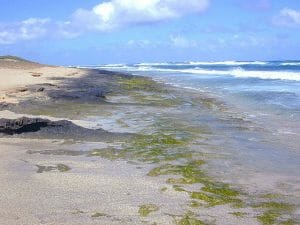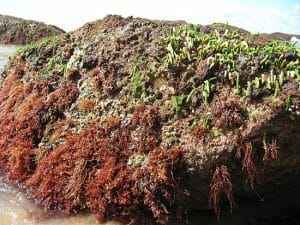Intertidal Zone Definition
The intertidal zone or “littoral zone” is the term used to describe the seashore which is covered during high tide and exposed during low tide, revealing a unique biome which survives under such fluctuating conditions (see below). The size and location of the intertidal zone varies with the region and provides a habitat for a wide variety of plant and animal species. Moreover, the intertidal zone is characterized by unique environmental conditions, including the temperature, ecological factors, and microclimates.

Intertidal Zone Temperature
The temperature of the intertidal zone is extremely variable depending on the time of day and the status of the tide. It is common for the temperature to change by as much as 20°C within a time span as short as six hours. Such fluctuations in temperature impose a substantial physiological stressor on the various species which reside within the intertidal zone. For example, the Crassostrea gigas is a species of Pacific oyster which inhabits the intertidal zone. This species of oyster must adapt to massive temperature fluctuations. While various stress responses within the organism enable it to survive in this habitat, the metabolic rate is heavily influenced by the temperature, as is the ability of the organism to reproduce. Since the massive temperature fluctuations is poses such a stress, there is increasing concern that climate change will increase the temperatures of this region to a point which limits survival of the organisms which inhabit the intertidal zone.
Intertidal Zone Location
The location of the intertidal zone is any interface between the land and sea which is exposed during low tide and submerged at high tide. The intertidal zone can encompass sandy beaches, rocky shores, bays, and estuaries. The intertidal zone is divided into four distinct regions:
Lower Littoral Zone
The lower littoral zone is the area of the intertidal zone closest to the sea, and is submerged the majority of the time. This zone exhibits the greatest species diversity as there are less drastic fluctuations in salinity, temperature, and water coverage. In addition, the coverage of shallow water and waves are protective against harmful solar radiation and the severe temperatures that affect the shorelines during the day. As such, the species inhabiting this region are typically larger in size, greater in number, and more diverse than the other areas of the intertidal zone.
Mid-Littoral Zone
The mid-littoral zone is submerged half of the time, depending on whether it is high or low tide. Many species of plants and animals still inhabit this region; however, not to the same number or diversity as exhibited by the lower littoral zone.
Upper Mid-Littoral Zone
The upper mid-littoral zone is submerged only during high tide, and few plant and animal species are able to survive in this region. Since this region is exposed most of the time, most of the animals residing within this zone are mobile (e.g., crabs) or attached to the substrate (e.g., barnacles attached to rocks).
Splash Zone
The splash zone is the zone above the upper mid-littoral zone, which may experience splash from waves during high tide, but is never fully submerged during high tide.
Intertidal Zone Animals
Several animal species reside within the intertidal zone, each divided by the zones created by the tide. In the lower littoral zone, which remains submerged the majority of the time, the organisms which inhabit this zone are generally larger, and protected from predation from the crashing waves. The organisms which reside in this zone include limpets, mussels, shrimp, crabs, tube worms, starfish, snails, and mollusks. In the mid-littoral zone, the organisms are equally exposed to water and land, depending on the tide. The animals residing within this zone include crabs, mussels, sea stars, sea sponges, snails, and limpets. The upper mid-littoral zone is only submerged under high tide, and thus, most organisms residing here are terrestrial. Organisms inhabiting this zone include, crabs, snails, mussels, and limpets. Finally, in the upper littoral zone, or spray zone, is dry the majority of the time, unless splashed with waves during high tide. Few organisms reside here, and include limpets, isopods, and barnacles.
Intertidal Zone Plants
Similar to the animal species residing within the intertidal zones, the vegetation which grows within each area is dictated by the relative exposure to water during the cycle of the tides. In the lower littoral zone, the plants are primarily adapted to water, including several species of seaweed, sea lettuce, sea palms, and green algae (see picture below). These plants are typically larger and grow taller than those located in the other zones. In the mid-littoral zone, some species of seaweed and green algae reside; these plants are typically smaller and there is decreased species variation within this region. In the upper mid-littoral zone, few plants reside, due to the stressful fluctuations in salinity, temperature, and submersion. The species which do reside within this region include algae and some seaweed which survives in tidal pools during low tides. In the splash zone, vegetation is rare.

Quiz
1. The most stressful location for plant and animal species in the intertidal zone is:
A. Lower littoral zone
B. Mid-littoral zone
C. Splash zone
D. Upper mid-littoral zone
2. The greatest abundance of species diversity is located in the lower littoral zone because:
A. The region is protected from solar radiation by water coverage and waves.
B. The zone is only exposed during low tide, enabling more stable conditions.
C. The zone is only submerged during high tide, enabling more stable conditions.
D. The region is protected from salinity due to shallow water coverage.
E. Only A and B are correct
F. Only A and C are correct
References
- Benes KM and Bracken ME. (2016). Nitrate uptake varies with tide height and nutrient availability in the intertidal seaweed Fucus vesiculosus. J Phycol. 52(5):863-876.
- Vernberg F and Vernberg W. (2001). The Coastal Zone: Past, Present, and Future. Nature. 161-182.
